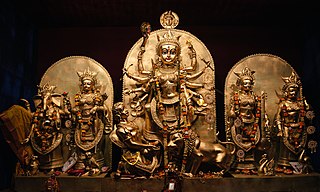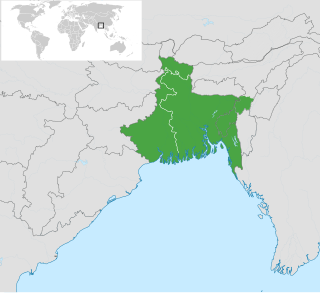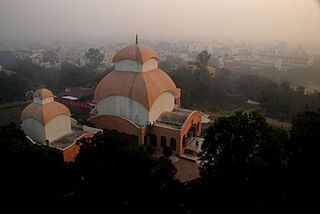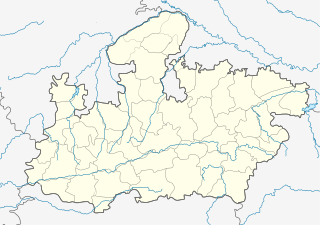This article relies largely or entirely on a single source .(February 2018) |

Delhi Durga Puja Samiti, also known as the Kashmere Gate Durga Puja is the oldest community Durga Puja (festival) of Delhi. [1] It is currently held in the lawns of Bengali Sr Sec School, Alipur Road, Delhi. It started in the year of 1910 at Roshanpura Kali Mandir near Nai Sarak as "Baroyari Puja" (Public Festival). It was an effort on the part of the probasi (settled) Bengalis living in the city, especially, of one Railway Doctor Hemchandra Sen (whose efforts saw the Puja being brought at a rented place at Roshanpura). Subsequently, Lala Lachminarayan & his son Lala Girdhari Lal helped the puja samiti grow by providing them space (from 1913 to 1946) in their Dharamshala located near Fathepuri Mosque.

Kashmere Gate or Kashmiri Gate is a gate located in Delhi, it is the northern gate to the historic walled city of Delhi. Built by the Mughal Emperor Shah Jahan, the gate is so named because it was at the start of a road that led to Kashmir.

Durga Puja, also called Durgotsava, is an annual Hindu festival in the Indian subcontinent that reveres the goddess Durga. It is particularly popular in the Indian states of West Bengal, Assam, Tripura, and Odisha, the modern-nation of Bangladesh and the diaspora from this region, and in Nepal where it is called Dashain. The festival is observed in the Hindu calendar month of Ashvin, typically September or October of the Gregorian calendar, and is a multi-day festival that features elaborate temple and stage decorations (pandals), scripture recitation, performance arts, revelry, and processions. It is a major festival in the Shaktism tradition of Hinduism across India and Shakta Hindu diaspora.

Delhi, officially the National Capital Territory of Delhi (NCT), is a city and a union territory of India containing New Delhi, the capital of India. It is bordered by Haryana on three sides and by Uttar Pradesh to the east. The NCT covers an area of 1,484 square kilometres (573 sq mi). According to the 2011 census, Delhi's city proper population was over 11 million, the second-highest in India after Mumbai, while the whole NCT's population was about 16.8 million. Delhi's urban area is now considered to extend beyond the NCT boundaries and include the neighboring satellite cities of Faridabad, Gurgaon, Sonipat, Ghaziabad and Noida in an area now called Central National Capital Region (CNCR) and had an estimated 2016 population of over 26 million people, making it the world's third-largest urban area according to United Nations. As of 2016, recent estimates of the metro economy of its urban area have ranked Delhi either the most or second-most productive metro area of India. Delhi is the second-wealthiest city in India after Mumbai and is home to 18 billionaires and 23,000 millionaires. Delhi ranks fifth among the Indian states and union territories in human development index. Delhi has the second-highest GDP per capita in India.
Contents
Prior to 1910, the first Durga Puja is believed to have been celebrated as far back as 1842 by one Majumdar of Rajshai, the next two were held in 1875 and 1904. However, all of them were Private Pujas and discontinued thereafter.
With Bengalis embracing English education with great enthusiasm, many had to leave home to serve in different parts of the country during British times. This brought a clutch of Bengalis to the city. And in 1911, when Delhi was officially declared the Capital of British India, a good chunk of them came to work in various government offices. These educated Bengalis formed a close knit community, unhindered by petty professional jealousies. This gave a huge thrust to the annual Durga puja celebrations. At first (in 1910 & 1911), the puja in Delhi was performed by ritually consecrating the ‘mangal ghata’ — the earthenware pot, symbol of the ‘Devi’. However, enthusiasm was unbounded when idol worship (pratima puja) started in 1912. With the help of the late Parmananda Biswas, who happened to be a Christian gentleman, an idol was brought from Varanasi (Kashi). Many Railway employees too made it possible to bring the idol from Kashi to Delhi. This arrangement continued till 1925. From 1926, the idol began to be made in the city itself. Since then its no looking back. Many eminent persons visited this Puja venue including the stalwarts like Netaji Subhas Chandra Bose in 1935 and Smt Indira Gandhi, the then PM, in 1969..

The British Raj was the rule by the British Crown on the Indian subcontinent from 1858 to 1947. The rule is also called Crown rule in India, or direct rule in India. The region under British control was commonly called India in contemporaneous usage, and included areas directly administered by the United Kingdom, which were collectively called British India, and those ruled by indigenous rulers, but under British tutelage or paramountcy, and called the princely states. The whole was also more formally called the Indian Empire. As India, it was a founding member of the League of Nations, a participating nation in the Summer Olympics in 1900, 1920, 1928, 1932, and 1936, and a founding member of the United Nations in San Francisco in 1945.

Idolatry literally means the worship of an "idol", also known as a worship cult image, in the form of a physical image, such as a statue. In Abrahamic religions, namely Christianity, Islam and Judaism, idolatry connotes the worship of something or someone other than God as if it were God. In these and several other monotheistic religions, idolatry has been considered as the "worship of false gods" and is forbidden. In many Indian religions, such as theistic and non-theistic forms of Hinduism, Buddhism and Jainism, idols (murti) are considered as symbolism for the absolute but not The Absolute, or icons of spiritual ideas, or the embodiment of the divine. It is a means to focus one's religious pursuits and worship (bhakti). In the traditional religions of ancient Egypt, Greece, Rome, Africa, Asia, the Americas and elsewhere, the reverence of an image or statue has been a common practice, and cult images have carried different meanings and significance.

Christians are people who follow or adhere to Christianity, a monotheistic Abrahamic religion based on the life and teachings of Jesus Christ. The words Christ and Christian derive from the Koine Greek title Christós (Χριστός), a translation of the Biblical Hebrew term mashiach (מָשִׁיחַ).
















